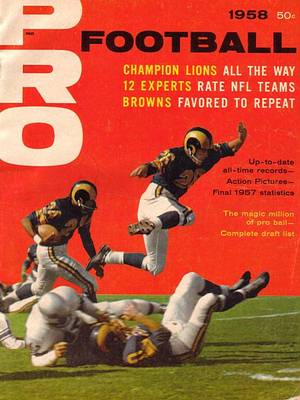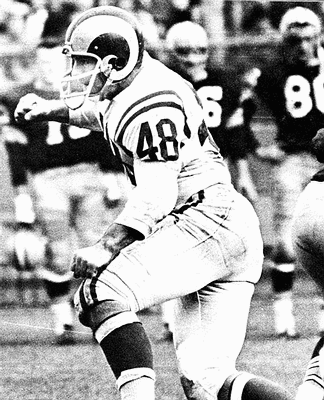

"HELMET REFLECTIONS"
HELMET NEWS, HELMET REFLECTIONS FOR APRIL 2008
By Dr. Ken
At the
age of eight, I was a full blown college football fan,
fueled by the black and white images on our tiny Dumont
television and the radio voices that brought the Army,
Columbia, and Notre Dame broadcasts to the New York Metro
region. When we moved to the small and
relatively deserted-during-the-winter town of Point Lookout
I got my first glimpse of high school football as the Long
Beach Marines faced off against the Uniondale Knights, an
image that has remained with me to this day. I immediately
“got” the excitement and importance of high school football
and it drove me through my preparation for college football
and beyond. Pro football was a blank, something that did not
invade my consciousness until 1958 at the age of eleven when
I saw a magazine that featured the Rams Jon Arnett on the
cover. He was leaping over a pile, leading “Touchdown Tommy”
Wilson and though I had no idea who these players were nor
what “pro football” was, I was still hooked. It wasn’t until
I heard the radio broadcast of the classic 1958 “Sudden
Death” Championship game between the Colts and Giants that I
figured out, with the assistance of a friend and family
members, that there was a football entity separate from the
college game. Though I was a Giants fan as every youngster
in our area seemed to be, the image of Arnett and photos I
saw of his teammate Les Richter, stayed with me.
 |
Arnett, a flashy, acrobatic running back originally out of USC, a former gymnast who announcers pointed out, could “leap over a pile, somersault, and land on his feet still running” joined Johnny Olszewski of Cal and the Redskins as my offensive inspiration. However, after seeing the Rams on television in 1959, I was smitten by what seemed to be the nastiest and toughest player I had observed to that point in time. Sam Huff may have been the defensive darling of the entire NFL and certainly the New York area, but my money was on the Rams’ Les Richter. For mayhem and pure nonstop contact at the point of impact, he became my guy. Even then, I needed to know more.
Many West Coast football fans of the early 1950’s knew well the California Bears and their stars, Olszewski and Fresno High School’s Les Richter. As a member of the freshman team, Johnny O viewed Richter as his varsity competition at fullback. Richter as a sophomore, had immediately established himself as a fearsome linebacker and despite being limited by injury, was drafted as a “future pick” by the NFL Dallas Texans after his first varsity campaign in 1949. He began that season at fullback but Head Coach Lynn “Pappy” Waldorf and his staff saw greater potential in moving Richter to offensive guard while allowing him to focus most of his energies at linebacker.and middle guard. An astonishing hitter, Richter would become the anchor for the defense and as they watched Olszewski’s frosh exploits, the coaches knew that Richter could become the wrecking ball that opened the holes for what appeared to be one of the most talented running backs on the coast. Utilizing this strategy, the Cal Bears posted a 9-0-1 record in 1950 before losing their Rose Bowl tilt against Michigan, with Richter a consensus All American. In ’51, Richter’s senior year, he was again everyone’s All American as he starred as a kicker, linebacker, and offensive guard and coincidentally, led what was Coach Waldorf’s last great Cal squad. The season finished at 8-2 but the offense, with Richter blocking and Johnny O running, rolled up a huge 638 yards against Minnesota and set a number of other Cal records. In addition to his All American distinction, Richter completed his collegiate career as team captain, played more minutes than any other Bear player, and won the MVP awards at both the East West Shrine and College All Star Games. Unknown to most sports writers, he was also the captain of Cal’s vaunted rugby team and valedictorian of his class.
The first round draft choice of the Dallas Texans, it was known by some NFL executives that Richter would be defending his country in the Korean War before he would be able to continue his football activities as a professional. He served as a First Lieutenant in the U.S. Army Infantry for two years before coming back to the States to continue his football career. Los Angeles Rams owner Dan Reeves was so eager to have this West Coast hero grace his roster that he traded eleven players for him, at the time, the biggest trade for one player in the history of the sport. He began his Rams’ career very much as he had done for the Cal Bears, playing both ways as an offensive guard and standout linebacker, and doing the team’s place kicking.
 |
By 1956, his hyperactive and very rough style found him with his uniform number changed from 67 to 48 and had Richter slated exclusively for defensive duty. For the following six seasons, he was the team’s defensive captain until his 1962 retirement. Interestingly, the Rams’ starting center Art Hunter went down with injury in ’62 and Richter got to finish his pro career the same way he started it, as a two-way star. Throughout his career, it was very much unnoticed that his kicking ability allowed him to score with 106 extra points and twenty-nine field goals. In an NFL-era dominated by excellent linebacker play and the likes of Chicago’s Bill George, Detroit’s Joe Schmidt, and the Packers’ Ray Nitschke, Richter completed his career as an eight-time Pro Bowl performer. As highly respected sports writer Mickey Herskowitz stated, “The Rams’ Les Richter didn’t get as much attention as Sam Huff or Joe Schmidt, but he might have been the best and toughest linebacker of his era.”
As an extremely talented individual Richter’s life after football was just as successful and rewarding. He was part of a group that included actor and comedian Bob Hope that purchased and then rehabilitated the Riverside Raceway and this began a motor sports revival in the Southern California area. Richter eventually became President of the Raceway and then Vice President of the California Speedway, until ascending to the position of Senior Vice President for NASCAR. For many in the motor sports, Richter’s accomplishments have been viewed as being much greater than the spectacular career he had on the gridiron.
Even at the age of eleven, my eye for football-related detail noted that something was “different” on the Rams’ jerseys. Often missed, the “different detail” related to the numbers. The beautiful durene Rams jersey, perfectly authenticating the 1957 home jersey that had the unique distinction of having a white outline around the front and rear gold numbers and gold sleeve numbers that were not outlined, was cut from the Southland pattern utilized by most professional teams in the late 1950’s. This “Jaguar” Jon Arnett number 26 model jersey alternately hangs among the memorabilia on display in my office, or is worn as part of my training attire as I am reminded to push myself as hard now as I did when preparing for my college football seasons so long ago. The 1957 Rams jersey is one of many offered by HR DERBY, a company that specializes in the type of painstaking authentic work that is reflected in all of HELMET HUT‘s products [see: http://hr-derby.com/ or email at: hr1derby@adelphia.net ].
The vision of Arnett sweeping to his left or Richter charging the middle of the opponent’s line to stuff the run were exciting images that still provide daily motivation and bring daily memories.